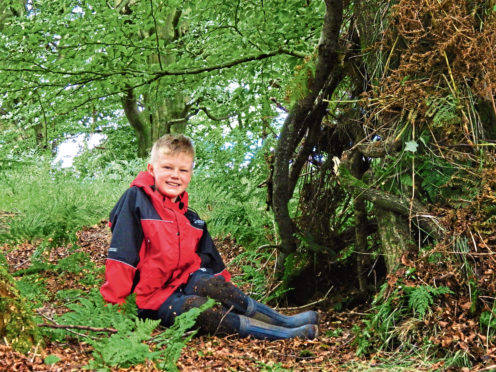
One of the highlights of childhood and, in my experience parenthood as well, is constructing your own den, although it is important to let the children take the lead.
Plans were made to go to the slopes of Cockleroy, the little hill above our house in Linlithgow, to build a shelter where we could enjoy a snack – which to my son was more important than anything.
When Eric was seven, countryside ranger Ben Dolphin ran a den-building birthday party for him, so who better to ask for some advice?
“It is a good chance to make kids think about the elements and environment,” Ben said.
So, a few days later we scouted around the woods, stopped for the first snack – a chocolate roll – and chose a low branch on which to build the epic construction. Then we began the collection of all the long sticks needed.
Ben had said gloves are OK, but the tactile nature of handling fallen wood was better, so we did it bare-handed – even though we discovered the gloopiest fungus ever seen in West Lothian.
Still gloveless – gloves were only for the “squeamish” according to Eric – we managed to complete the skeleton of the structure, a bit like a tent with lots of poles.
Although the urge for another snack was there, the desire to get on was stronger, so various thin branches were weaved through to make a kind of lattice work.
The hunter gatherers of ancient times may have sighed at our work but it was fun and allowed a different perspective on the woods as you studied them in minute detail in the hunt for perfect building material.
Then came the water-proofing. Ben had said to pick “nothing green” so big ferns were out. But dry, apparently dead, grass seemed a good substitute until we realised that the roots were still alive.
“We should use the dead ferns, that’s much better for the environment,” said 10-year-old Eric, proving it can be best to let children take the lead.
Then, as it became apparent there was a big gap on one side, came the biggest discovery of the day.
“That could be a window!”
A few tweaks, extra branches and more dead ferns meant that after less than a couple of hours there was the perfect den.
Eric cleared the leaf litter from inside, collected a cut-off tree stump to use as a seat and promptly sat down inside before devouring what we had really come for – a snack, flapjack this time.
Top tips for dens:
Pick a dry spot, and think about which way the wind is blowing when deciding where you want to place your entrance.
Make sure you’re in open land where it is safe to construct a den.
To make a free-standing den, make an A-shaped entrance with two long sticks. Then find an even longer stick to form the spine of the den to make a sturdy tripod. Place sticks vertically along the spine so it looks like a tent, then weave brashy material horizontally through the sticks, before covering with something such as leaf litter.

Enjoy the convenience of having The Sunday Post delivered as a digital ePaper straight to your smartphone, tablet or computer.
Subscribe for only £5.49 a month and enjoy all the benefits of the printed paper as a digital replica.
Subscribe